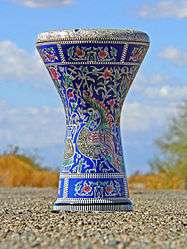Qanbūs
A qanbūs or gambus (Arabic: القنبوس) is a short-necked lute that originated in Yemen and spread throughout the Arabian peninsula. Sachs considered that it derived its name from the Turkic komuz, but it is more comparable to the oud.[1] It has twelve nylon strings that are plucked with a plastic plectrum to generate sound, much like a guitar. However, unlike a guitar, the gambus has no frets. Its popularity declined during the early 20th century reign of Imam Yahya; by the beginning of the 21st century, the oud had replaced the qanbūs as the instrument of choice for Middle-Eastern lutenists.
Yemen migration saw the instrument spread to different parts of the Indian Ocean. In Muslim Southeast Asia (especially Indonesia, Malaysia and Brunei), called the gambus, it sparked a whole musical genre of its own. Today it is played in Johor, South Malaysia, in the traditional dance Zapin. In the Comoros it is known as gabusi,[2] and in Zanzibar as gabbus.
Sources
- ↑ The gambus (lutes) of the Malay world: its origins and significance in zapin Music, Larry Hilarian, Nanyang Technological University, Singapore, 06 Jul 2004
- ↑ Simon Broughton; Mark Ellingham; Richard Trillo (1999). World Music: Africa, Europe and the Middle East. Rough Guides. pp. 505–. ISBN 978-1-85828-635-8. Retrieved 18 September 2012.
References

- Poche, Christian. "Qanbūs". Grove Music Online (subscription required). ed. L. Macy. Retrieved on August 15, 2007.
- Gambus - Musical instruments of Malaysia
- Charles Capwell, Contemporary Manifestations of Yemeni-Derived Song and Dance in Indonesia, Yearbook for Traditional Music, Vol. 27, (1995), pp. 76–89 reg
See also
Further reading
- Qanbus, Kigangala, & Gabusi: A Portfolio. Monoxyle Lutes/Index v.21 March 2016
